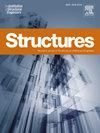爆炸荷载作用下钢筋混凝土柱概率响应评估的可解释自然梯度提升模型
IF 4.3
2区 工程技术
Q1 ENGINEERING, CIVIL
引用次数: 0
摘要
在爆炸荷载作用下,钢筋混凝土(RC)结构容易发生由柱破坏引起的部分或完全逐渐倒塌。了解和预测RC柱在爆炸荷载作用下的响应对于实施主动解决方案以保护生命和减少经济损失至关重要。本研究旨在采用新的机器学习算法NGBoost (Natural Gradient Boosting)建立爆炸荷载作用下RC柱的概率位移预测模型,并通过对所建立的NGBoost模型的解释,了解设计参数对RC柱位移响应峰值及其离散性的影响。研究结果表明,与单自由度(SDOF)方法相比,开发的NGBoost模型具有更高的精度,同时提供了对预测不确定性的稳健估计。爆炸荷载的反射冲击和反射压力特征对混凝土柱在爆炸荷载作用下的位移响应的影响远大于设计参数。纵向钢筋配筋率和混凝土抗压强度等设计参数对峰值位移的影响显著,而纵向钢筋屈服强度、横向钢筋屈服强度和混凝土抗压强度对爆炸荷载作用下钢筋混凝土柱位移响应的离散性影响显著。这些研究结果可为加强钢筋混凝土柱抗爆炸荷载的设计提供实用参考。本文章由计算机程序翻译,如有差异,请以英文原文为准。
Interpretable natural gradient boosting model for probabilistic response evaluation of RC columns under blast loads
Reinforced concrete (RC) structures are susceptible to partial or complete progressive collapse initiated by column failures under blast loads. Understanding and predicting the RC column’s responses subjected to blast loads is crucial for implementing proactive solutions to protect life and mitigate economic loss. This research aims to develop a probabilistic displacement prediction model for RC columns under blast loads by adopting a new machine learning algorithm, Natural Gradient Boosting (NGBoost), and to understand the influence of design parameters on the peak and the corresponding discreteness of the RC column’s displacement responses by interpreting the developed NGBoost model. The research outcomes demonstrate that the developed NGBoost model achieves superior accuracy compared to the single-degree-of-freedom (SDOF) method, concurrently offering robust estimates of prediction uncertainties. The feature of the blast loads, including the reflected impulse and reflected pressure, shows a much higher influence than the design parameters on the displacement responses of the RC columns under blast loads. Design parameters such as longitudinal steel reinforcement ratio and concrete compressive strength exhibit noteworthy influence on peak displacement, while longitudinal steel yield strength, transverse steel yield strength, and concrete compressive strength significantly impact the discreteness of the RC column's displacement responses under blast loads. These insightful findings can serve as practical references for enhancing the design of RC columns against blast loads.
求助全文
通过发布文献求助,成功后即可免费获取论文全文。
去求助
来源期刊

Structures
Engineering-Architecture
CiteScore
5.70
自引率
17.10%
发文量
1187
期刊介绍:
Structures aims to publish internationally-leading research across the full breadth of structural engineering. Papers for Structures are particularly welcome in which high-quality research will benefit from wide readership of academics and practitioners such that not only high citation rates but also tangible industrial-related pathways to impact are achieved.
 求助内容:
求助内容: 应助结果提醒方式:
应助结果提醒方式:


